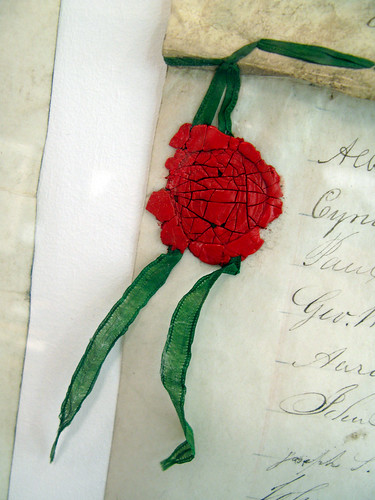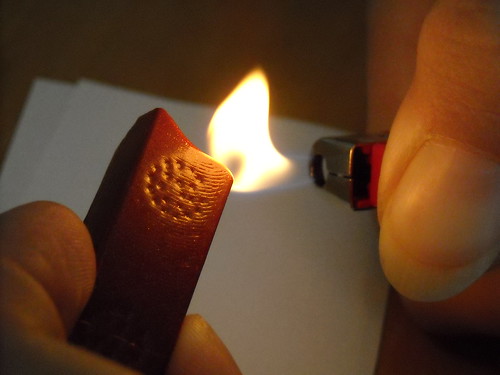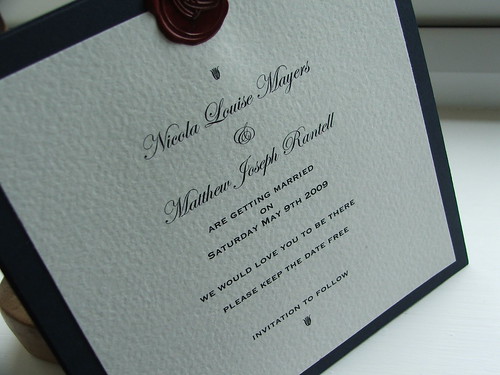
Seals have been traced back to 930 AD. It served as a stamp of indisputiable authenticity , just as a signature is accepted in the world today. Seal were used by kings and governments long ago. New laws and proclamations required the authorative stamp of a seal.
 (Letters sealed with sealing wax in a painting by Cornelis Norbertus Gysbrechts (1665) - Wikipedia)
(Letters sealed with sealing wax in a painting by Cornelis Norbertus Gysbrechts (1665) - Wikipedia)Long ago, bethrothals were prearranged - therefore true words of love were secretly written and the envelope's contents secured by a seal, so that the recipient could be assured that their passion would be unknown to others. A broken seal implied broken trust and no person of integrity would tamper with a wax emblem.

Recipes vary, but there is a major shift after European trade with the Indies opened. In the Middle Ages sealing wax was typically made of beeswax and "Venice turpentine", a greenish-yellow resinous extract of the European Larch tree. The earliest such wax was uncoloured, somewhat later the wax was coloured red with vermilion. From the 16th century it instead was compounded from a mixture of various proportions of shellac, turpentine, resin, chalk or plaster, and colouring matter (often still vermilion, or else red lead), but not necessarily beeswax. The proportion of chalk varied; coarser grades are used to seal wine bottles and preserves, finer grades for documents. In some situations, such as large seals on public documents, beeswax was actually used. On occasion, sealing wax has historically been perfumed by ambergris, musk and other scents.

By 1866 many colors were available: gold (using mica), blue (using smalt or verditer), black (using lamp black), white (using lead white), yellow (using trupeth mineral), green (using verdigris) and so on. Some users such as the British Crown assigned different colours to different types of documents. Today a range of synthetic colours is available.
Sealing wax is available in the form of sticks, sometimes with a wick, or as granules. The stick is melted at one end (but not ignited or blackened), or the granules heated in a spoon, normally using a flame, and then placed where required, usually on the flap of an envelope. While the wax is still soft, the seal (being preferably at the same temperature as the wax, for the best impression) should be quickly pressed into it and released.

Modern day has brought sealing wax to a new level of use and application. Since the advent of a postal system, the use of sealing wax has become more for ceremony than security. Modern times have required new styles of wax to be created, allowing for mailing of the seal without damage or removal. These new waxes are flexible for mailing and are referred to as glue gun sealing wax, faux sealing wax, and flexible sealing wax.

There are traditional sealing wax candles still produced in France and Scotland, using similar formulas as those in the days of hand-carried correspondence. (Source - Wikipedia)
I learned the hard way that you can only mail wax seals specifically made for that purpose. The seals crack and leaves pretty sharp pieces behind. I reserve its use for cards on special occasions - such as the giveaway!
(Oh, and as you might have noticed, I changed my background. I was ready for a change!)

I remember when I was a kid I tried to use old flat-topped rings to make my own seals... naturally, that didn't really work due to lack of special wax!
ReplyDeleteI'd love to use seals, but not many people appreciate them. I love them, though! Yours look lovely.
Wax seals are so special. They look sensational
ReplyDeleteAlison
I have been intrigued by wax seals for a long time. Thanks for the lesson in their history!
ReplyDeleteI found an olllllllld wax seal stamp in a creek near my house no where I might look to find out more about it?
ReplyDelete